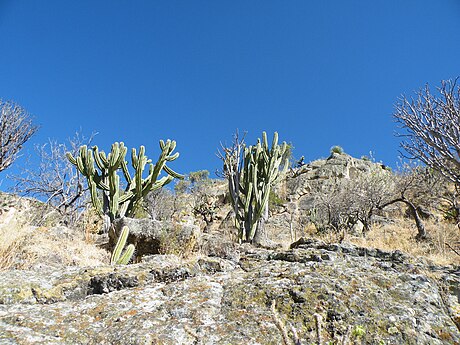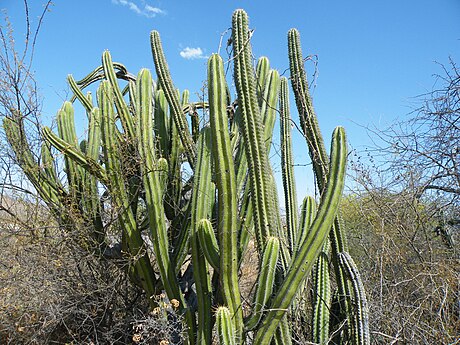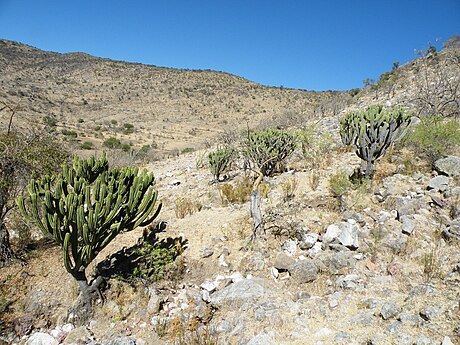Polaskia chende
| Polaskia chende | |
|---|---|

| |
| Scientific classification | |
| Kingdom: | Plantae |
| Clade: | Tracheophytes |
| Clade: | Angiosperms |
| Clade: | Eudicots |
| Order: | Caryophyllales |
| Family: | Cactaceae |
| Subfamily: | Cactoideae |
| Genus: | Polaskia |
| Species: | P. chende
|
| Binomial name | |
| Polaskia chende (Rol-.Goss.) A.C.Gibson & K.E.Horak
| |

| |
| Distribution of Polaskia chende | |
| Synonyms[2] | |
| |
Polaskia chende is a succulent cactus native to a small area of mountains of northern Oaxaca and southern Puebla, Mexico. It grows in xerophytic shrubland between 1,500 and 2,000 meters above sea level.[1]
Description
[edit]Polaskia chende forms 3–5 m (9 ft 10 in – 16 ft 5 in) tall branching columnar stems, 40 to 80 cm long and 5 to 7 cm wide, and can reach up to 4.5 m in height. 7 to 8 ribs, rarely 9, 1.7 to 3 cm high, areoles 5 mm long, circular to elliptical, spaced 2 cm apart, with the presence of black trichomes. It has 5 or 6 radial spines 2 cm long and 0.8 cm wide, grey, the central spine may be absent or rudimentary; fertile zone not differentiated from the infertile zone. Plants bloom between August and January. Its flowers are white reach a length of 5 cm oblanceolate, mucronate apex, green, some with a red to purple middle stripe. The fruit approximately 3 cm long and 4 cm wide, are purple, with short bracts, yellow trichomes, with short spines, juicy purple pulp. Seeds 1.6 mm long and 1 mm wide. Flowering occurs between the months of August and January, and bears fruit between December and June.[3][1]
Distribution
[edit]It inhabits oak (Quercus) forests, xeric scrublands, tropical deciduous forests, and among riparian vegetation, at elevations from 1700 to 2200 meters.
Taxonomy
[edit]The plant was initially named Cereus chende, was described by Robert Roland-Gosselin in 1905.[4] The specific epithet "chende" comes from its Spanish common name. In 1979, Arthur Charles Gibson and Karl E. Horak reclassified the species under the genus Polaskia.[5]
References
[edit]- ^ a b c The IUCN Red List of Threatened Species (2013). "Polaskia chende". IUCN Red List of Threatened Species. 2013: e.T151722A121564109. doi:10.2305/IUCN.UK.2017-3.RLTS.T151722A121564109.en. Retrieved 20 February 2022.
- ^ "Polaskia chende (Rol-.Goss.) A.C.Gibson & K.E.Horak". Retrieved 20 February 2022.
- ^ "Polaskia Species, Chende, Chinoa, Tunillo (Rol-.Goss.) A.C.Gibson & K.E.Horak". Dave's garden. Retrieved 20 February 2022.
- ^ D&Amp, Um National; (France), histoire naturelle (1905). "Bulletin du Muséum d'histoire naturelle". Impr. nationale. ISSN 0027-4070. Retrieved 2024-03-31.
- ^ Garden., Missouri Botanical; Botany., Henry Shaw School of (1978). "Annals of the Missouri Botanical Garden". Missouri Botanical Garden Press. Retrieved 2024-03-31.
External links
[edit] Media related to Polaskia chende at Wikimedia Commons
Media related to Polaskia chende at Wikimedia Commons Data related to Polaskia chende at Wikispecies
Data related to Polaskia chende at Wikispecies




